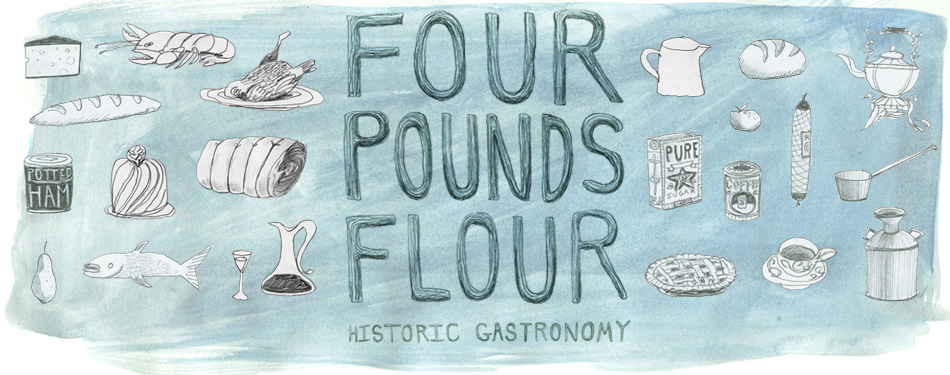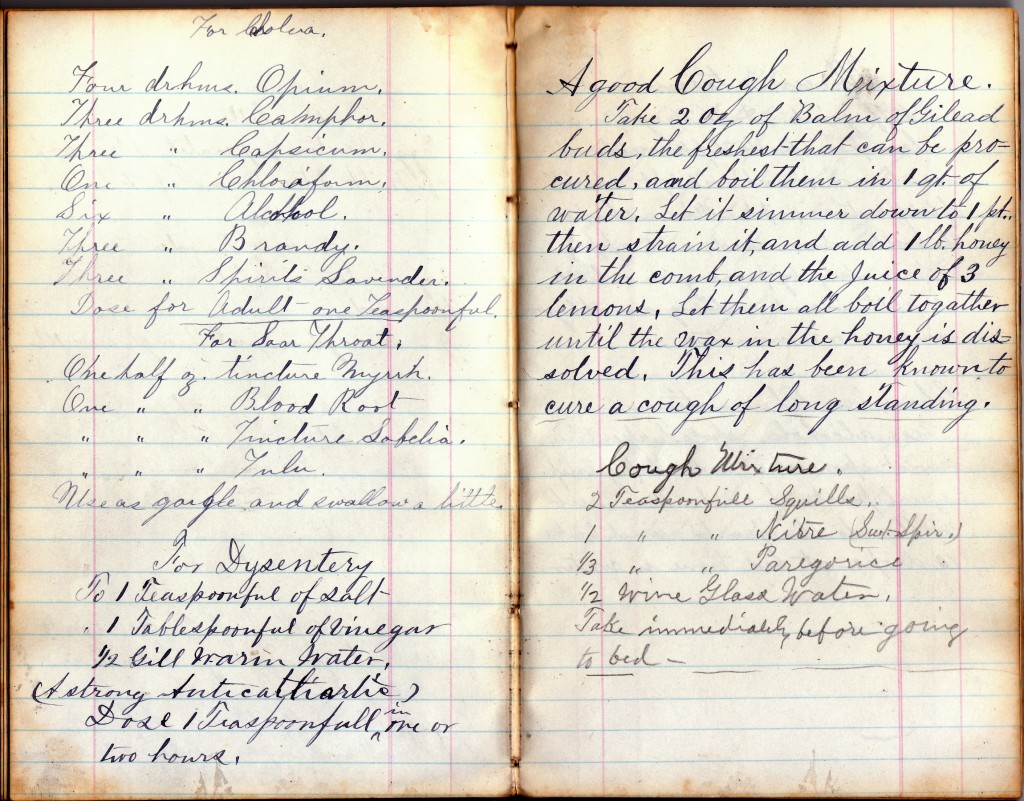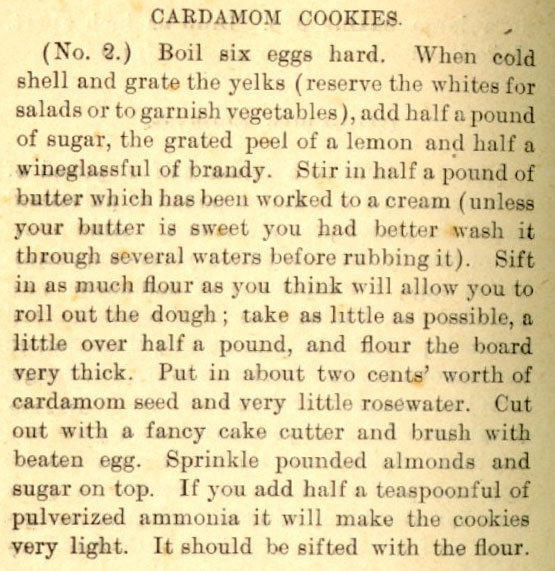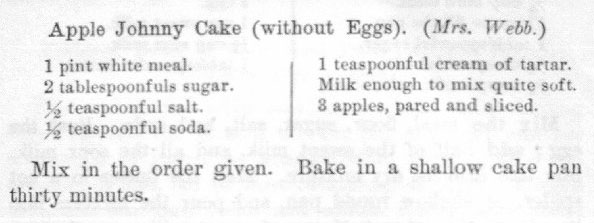A few pages from the beginning of the journal, where Annie S. Bush wrote her recipes.
Category Archives: 19th century
The Gallery: For Cholera. For Dysentery.
These pages come from a handwritten, leather bound journal that was given to me for Christmas. It belonged to a friend’s grandmother; the inside cover is signed “Annie S. Bush” and “Warren Koons.” According to my friend, Warren is a relation of her grandmother, and Annie Bush was Warren’s first wife. She was born June 20, 1854 and died Sept 1, 1883. I suspect Warren picked up the book after his wife died (her signature appears to be written earlier) and wrote in it until his untimely death in 1910. Warren and his second wife were brutally murdered by their son-in-law: read the New York Times article here.
In addition to home remedies like these, the book is full of beer and wine recipes; baked good reciepts from Annie; and a study of wild mushrooms. I’ll be sharing more pages over the next week.
The History Dish: Birthday Cakes
It’s my birthday today! So naturally, I got curious about the history of birthday cakes. This is the earliest b-day recipe on the books, from Jennie June’s American Cookery Book, published 1870:
The “cakes” are actually cookies; but the most interesting part of this recipe is the directions to “sprinkle colored caraway seeds on top.” Colored could perhaps mean “toasted.” It could mean dyed with natural dyes. It could mean candied.
But does it mean that “colored caraway seeds” are proto-sprinkles? Jimmies? Hundreds and Thousands?
Thoughts?
At any rate, I decided not to make these cakes for my birthday: I anticipate them to be floury, dry, and full of currants. Very 19th century and not my favorite style of cookie. Instead, I’m baking an apple up-side-down cake and a plum cake, and my friend Jeffrey is arriving with a vegan delight. The more cakes, the better, I say.
Beaver Bonanza Part II: A Brief History of Beaver
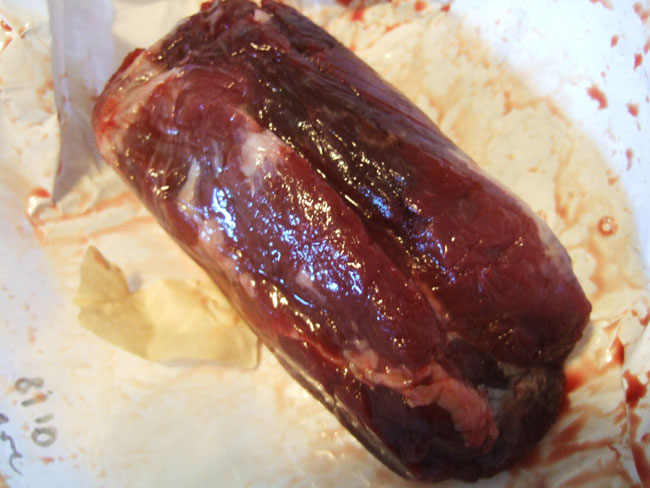 Bloody beaver.
Bloody beaver.
My first challenge after my beaver meat arrived was to put it in some historical context and to see if there was a precedent for beaver eating. I turned to Thomas De Voe, the man in charge of New York City’s food markets in the middle of the 19th century, who also wrote The Market Assistant: Containing a brief description of every article of human food sold in the public markets of the cities of New York, Boston, Philadelphia, and Brooklyn; including the various domestic and wild animals, poultry, game, fish, vegetables, fruits &c., &c. with many curious incidents and anecdotes. Did he know how indispensable his book would be to future historians?
I checked out his passage on beaver and came to an amazing realization: Victorians weren’t eating beaver, because by the middle of the 19th century, they had hunted it to near extinction. Beaver pelts were too valuable for their fashion cred, in terms of muffs, coats, and hats. Here’s what De Voe says:
This animal was once a native here, but civilization and the beaver’s valued skin have almost exterminated the family, although now and then a specimen is taken in our State. It is said the ‘flesh of this animal is greatly prized by hunters and voyageurs, especially when roasted in the skin after the fur is singed off. ‘ This of course is an expensive luxury and is frowned upon by the fur traders. ‘Care must be taken, however, to examine the herbage on which the animals feed, or mischief may follow an unwary repast. Mr. Ross’s party were once poisoned by feasting heartily on beaver and some of them had a very narrow escape. The Indians eat this kind of beaver but they roast it; boiled, they say, it is pernicious.’
Professor Kalm, in his ‘Travels in America,’ in 1748, says ‘Beaver flesh is eaten, not only by the Indians, but likewise by the Europeans, and especially by the French on their fasting days; for his Holiness, in his system, has ranged the beaver among the fish. The flesh is reckoned best if the beaver has lived upon vegetables. The tail is likewise eaten after it has been well boiled and roasted afterwards.
So, according to what De Voe has heard: 1. Beaver is good roasted. 2. Beaver can be poisonous. (Perhaps not poison, but I suspect, that like bear, the beaver’s diet varies by season from one based heavily on plants and berries, to one based on fish. The latter can give the meat an unpleasant, fishy taste. ) 3. A beaver is a fish, therefore it can be eaten on Fridays. (Good news for you Catholics out there.) 4. Beaver tail is damn tasty.
I know number three to be true, thanks to a great post at the French Culinary Institutes’s blog, Cooking Issues. Not too long ago, they ordered up some exotic meats from Crizmer’s outside of Chicago, including both beaver tail and beaver flapper, which are two different things. Of the beaver tail, they said “Beaver tail is straight up fantastic. It has a woody-musky aroma and flavor that is unique among all meats I have tried…Man, was it good.” This statement gave me hope, as I prepped my beaver meat for consumption.
Tomorrow: recipes and the big beaver tasting.
Menus: A Cratchit Christmas
The holidays have come and gone, but file this away for next year: a Christmas dinner based off of Dickens’s classic, a Christmas Carol. The following menu has been pulled from the description of Bob Crachit’s feast on Christmas Eve — not a sad, meager meal, as it is often portrayed in film interpretations of the story. But rather a proud day, when the family pooled their modest resources to create a filling feast and a happy occasion. Read the excerpt from the original story here.
The menu items are linked to the historic or contemporary recipes.
Roast Goose with Sage and Onions
Gravy
Mashed Potatoes
Apple Sauce
Christmas Plum Pudding in Blazing Brandy
Cock-tail; Gin Sling; Hot Spiced Rum; Charles Dickens Punch
This was the first time I had ever roasted a goose and I was a little disappointed. Water birds have immense chest cavities, so what appears to be a large bird actually does not has a lot of meat. A ten pound goose produced a tiny pile of meat; although what few bites I had tasted good. Knowing that, it’s not a surprise that Scrooge buys the family a big, meaty turkey at the end of the book.
I wasn’t sure how the plum pudding was going to light on fire, but after some discussion, we doused the hot dessert in warm brandy and held a lighter to it, and it was soon engulfed in flame. It was a very impressive end to the meal.
We also played a rousing game of Snapdragon, which involves plucking raisins out of a pan of burning brandy. It’s a lot less dangerous that it sounds.
Cocktail Hour: Charles Dicken’s Punch
I threw a Charles Dickens A Christmas Carol themed dinner party for some of my friends in Cleveland this week; more details on the full menu later. Today, I want to focus on the punch that we served, from Charles Dicken’s own recipe.
I came across the Dicken’s punch in David Wondrich’s new book, Punch!, while looking for an appropriately themed drink for the party. Coincidentally, NPR just did a piece on the same concoction, and published an interview with Wondrich:
“Dickens always made punch for friends,” Wondrich says. “Whenever he entertained, it was part of his ritual.”
Punch was already out of style by the mid-19th century, but that was part of the fun for Charles Dickens. The English novelist was “a great antiquarian,” says drink historian David Wondrich.But even for Dickens in the mid-1800s, punch was something of a throwback. “By his day,” Wondrich explains, “punch had gotten kind of old-fashioned. Queen Victoria was very opposed to the lax moral standards that the upper classes in particular had held to in her predecessor’s days. And she didn’t like their habit of getting grossly drunk on punch and champagne and wine.”So punch was out of style — but that was part of the fun. “[Dickens] was a great antiquarian,” Wondrich says. “He liked to collect all the old customs and habits of old England.” So he’d invite his friends over, concoct a big bowl of punch, and then describe the punch-making process for his guests. (read the full article here)
This punch recipe came from a letter Dickens wrote to his friend, Amelia Filloneau in 1847. The full text of the original recipe is below, followed by my modernized version (based on suggestions from both Dickens and Wondrich). It’s a standard punch recipe, the kind made better by rubbing the sugar on the rinds of the lemons and substituting green tea for the hot water.
We found the punch to be on the sweet side, so consider initially adding less sugar and then sweetening to taste. Overall, it’s a delightful treat to take to your New Year’s party tonight.
***
Charles Dicken’s Punch
Adapted from a letter from Dickens to Amelia Filloneau, 1847.
From the book Punch: The Delights and Dangers of the Flowing Bowl by David Wondrich.
Peel into a very strong common basin (which may be broken, in case of accident, without damage to the owner’s peace or pocket) the rinds of three lemons, cut very thin, and with as little as possible of the white coating between the peel and the fruit, attached. Add a double-handfull [sic] of lump sugar (good measure), a pint of good old rum, and a large wine-glass full of brandy — if it not be a large claret-glass, say two. Set this on fire, by filling a warm silver spoon with the spirit, lighting the contents at a wax taper, and pouring them gently in. [L]et it burn for three or four minutes at least, stirring it from time to Time. Then extinguish it by covering the basin with a tray, which will immediately put out the flame. Then squeeze in the juice of the three lemons, and add a quart of boiling water. Stir the whole well, cover it up for five minutes, and stir again. At this crisis (having skimmed off the lemon pips with a spoon) you may taste. If not sweet enough, add sugar to your liking, but observe that it will be a little sweeter presently. Pour the whole into a jug, tie a leather or coarse cloth over the top, so as to exclude the air completely, and stand it in a hot oven ten minutes, or on a hot stove one quarter of an hour. Keep it until it comes to table in a warm place near the fire, but not too hot. If it be intended to stand three or four hours, take half the lemon-peel out, or it will acquire a bitter taste. The same punch allowed to cool by degrees, and then iced, is delicious. It requires less sugar when made for this purpose. If you wish to produce it bright, strain it into bottles through silk. These proportions and directions will, of course, apply to any quantity.
(Doubled, for a party of 20)
Zest and juice of 6 lemons
3 cups sugar (or simple syrup)
4 cups rum (about 1 liter)
1 1/5 cups cognac (about 1/4 liter)
2 quarts boiling water
1. Pare the zest off of the lemons, being careful to get as little as the bitter white as possible. Add to a heat-safe bowl or pot, along with simple syrup. Add alcohols.
2. Gently warm a metal spoon (for example, over a stove burner). Take a spoonful from the alcohol mixture and gently light the spoon with a match or candle. Pour the spoonful of flaming liqour back into the larger bowl. “Let burn three or four minutes, stirring it from time to time.” Extinguish flame by covering the bowel with a tray or lid.
3. Squeeze the lemon and add the juice to the punch, being careful not to add any seeds, or to strain them out immediately. Add boiling water.
4. Taste; if not sweet enough, add additional sugar. Warm over a stove top burner or hotplate on low for fifteen minutes before serving.
Cookie Week: Cardamom Rosewater Cookies
This will be the last post for Cookie Week, which will hopefully also allow me to stop devouring cookies. I’m on holiday vacation through New Years, so my consumption of holiday treats is slackening at a snail’s pace.
But if you are going to make one more sweet this season, I’d recommend these cookies. They taste beautiful.
The original recipe is fairly complex. Here:
If anyone has an explanation for the grated boiled eggs yolks, I’d love to hear it. Has anyone ever seen anything like it in a recipe before? When my mother and I were doing some holiday baking, we experiemented with this technique in another cookie recipe and the result was revolting: dense, dry cookies with a distinctly hard-boiled taste (although roommate DK loved them).
But what I loved about this cookies recipe was the flavor combination: cardamom, rosewater, and brandy. Definitely 19th century but daring to the modern pallette. I decided to focus on the flavors of the recipe, not the technique, and retronovate a modern sugar cookie recipes to incoporate a taste of the past.
***
Cardamom Rosewater Cookies
Adapted from “Aunt Babette’s” Cook Book by “Aunt Babette”, c1889.
Modern recipe derived from Martha Stewart’s Cookies.
3 cups all-purpose flour
1 teaspoon baking soda
1/4 teaspoon salt
1 tsp ground cardamom
1 1/2 cups granulated sugar
1/2 cup packed light-brown sugar
1 cup unsalted butter (2 sticks), softened
2 large eggs
1 tsp rosewater
1 tsp brandy
Zest of one lemon
Sanding sugar, for sprinkling
1. Preheat oven to 350 degrees. Whisk flour, baking soda, cardamom and salt into a bowl; set aside. Beat eggs with rosewater, brandy, and lemon zest; set aside.
2. Using an electric mixer, beat sugars and butter at a medium speed until pale and fluffy. Add eggs until mixed. Scrape down bowl with a rubber spatula
3. Reduce mixer speed to low and gradually add flour mixture. Mix until just combined.
4. Scoop dough into a Ziploc bag or sheet of plastic wrap. Form into a ball and refrigerate for at least an hour.
5. Either roll dough into 1 inch balls and place on a baking sheet; or, roll and cut cookies. On a generously floured surface, roll out 1/4 of the dough until it is 1/4 inch thick. “Cut out with a fancy cake cutter,” and place on a baking sheet. Brush with egg white and sprinkle with sanding sugar and/or chopped almonds.
6. Bake for 7 minutes, turning half-way through.
***
This cookie isn’t for everyone. It won’t satisfy your chewy/chocolate/nutty holiday treat cravings. But the flavor is unique and surprising: a refreshing palette cleanser after a month of heavy eating.
Retronovated Recipes: Make Yourself a Ham and Apple Cornbread Sandwich
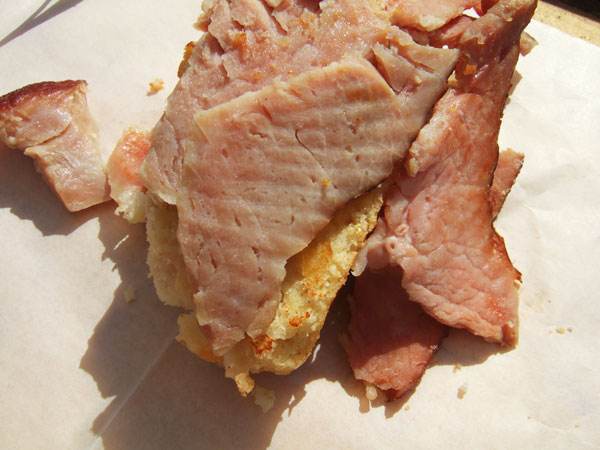 Toasted apple cornbread, melted butter, and hot ham. Sound ok to you?
Toasted apple cornbread, melted butter, and hot ham. Sound ok to you?
I served this delicious sandwich at an 1864-style baseball game where I was charged with providing a few period-appropriate concessions. I was inspired to create this flavor combo after stumbling across this recipe (albeit from 1884) from Mrs. Lincoln’s Boston Cook Book for Apple Johnny Cake:
Apples stirred in to cornbread? Awesome! Why had I never heard of this before?
I initially made the cornbread according to the historic recipe; it was very dry, grainy, and crumbly. Not pleasant. I prefer a cakier, modern cornbread. So I retronovated: I grabbed my favorite contemporary cornbread recipe (Mark Bittman’s) and folded in about a cup of chopped apples at the end.
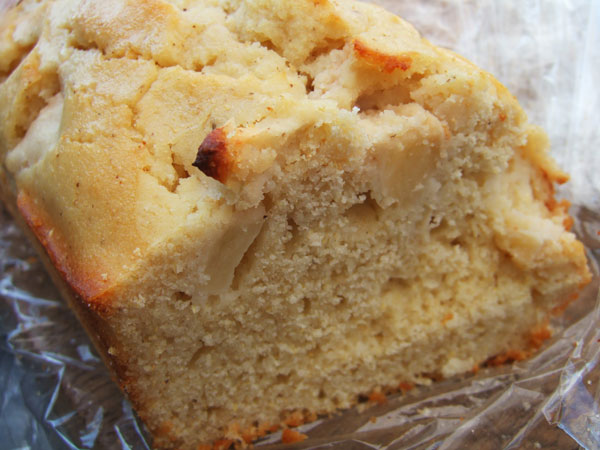 A cross section of cornbread and apples.
A cross section of cornbread and apples.
Cornbread and ham were common foods served at fairs and political rallies in the 19th century, so it only made sense to pair my apple cornbread with a thick slice of ham. At the baseball game, I toasted the cornbread on a griddle and heated a slice of ham alongside. The cornbread got a healthy smear of fresh, handmade, sooo-yellow butter I got at Saxelby’s Cheese in the Essex Street Market. Seriously, one forgets how yellow fresh butter is.
Anyway: cornbread, butter, and hot ham on top. It was a damn good sandwich.
The History Dish: Apple Pan-Dowdy
 I first made Apple Pan Dowdy way back in July, for the Edible Queens summer issue. Originally part of an article about a traditional Fourth of July dinner, this dish is also perfect for this time of year. Apple usage? High. Simple? Indeed, because the end product is far from glamorous: a sloppy, delicious mess of baked appleness. I could line up testimonials about how good this dessert is; it’s one of the recipes I’ve made this past year that I get requests for again and again.
I first made Apple Pan Dowdy way back in July, for the Edible Queens summer issue. Originally part of an article about a traditional Fourth of July dinner, this dish is also perfect for this time of year. Apple usage? High. Simple? Indeed, because the end product is far from glamorous: a sloppy, delicious mess of baked appleness. I could line up testimonials about how good this dessert is; it’s one of the recipes I’ve made this past year that I get requests for again and again.
You can choose to use either real maple syrup or molasses to sweeten the apples; each adds a distinctive flavor. The molasses has a strong taste, so if you’re a fan of dark sugars and ginger breads, that’s the way to go. But for a lighter finish, the maple syrup delivers a surprisingly clean and gentle flavor.
***
Apple Pan Dowdy
Adapted from American Heritage Cookbook, 1964 and Miss Corson’s Practical American Cookery by Juliet Corson, 1886.
1 9-inch pie crust, store-bought or homemade
5 large baking apples, peeled, cored and cut into ¼-inch-thick slices
½ cup sugar
½ tablespoon freshly squeezed lemon juice
½ teaspoon cinnamon
½ teaspoon salt
¼ teaspoon freshly grated nutmeg
½ cup maple syrup or molasses
¼ cup water
3 tablespoons unsalted butter, melted
1. Preheat oven to 400°F. In large bowl, gently toss together first six ingredients.
2. Use half the crust to line the bottom of an 8- by 11-inch baking dish. Top with apple mixture. In small bowl, whisk together maple syrup, melted butter and water; pour over apples. Cover apples with remaining pie crust by weaving together wide strips, or by simply scattering torn pieces of crust over the top. Bake 10 minutes.
3. Remove from oven and“Dowdy” the crust by pushing it down into the apples with a knife. Reduce heat to 325° and bake one hour more.
4. Serve hot or cold with a dollop of whipped cream.
The History Dish: Pear Ice
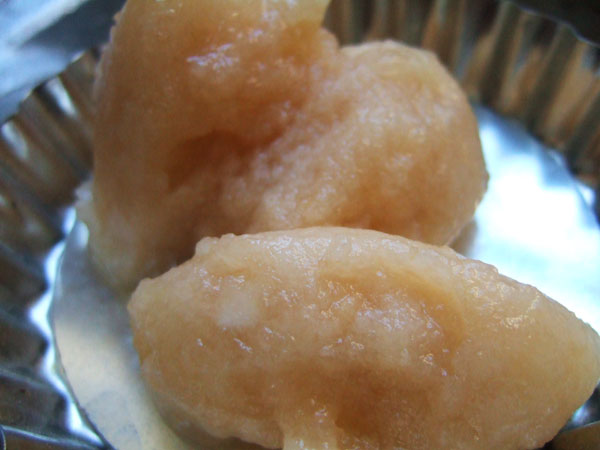 Three frozen baby food blobs of pear ice.
Three frozen baby food blobs of pear ice.
If you love eating things that are slimy and gross, you’ll love Pear Ice.
This recipe is the last in the triumvirate of pear creations selected on We Dig Plants. This one was my pick; I loved it because it was so simple. From Buckeye Cookery, published in 1877, the recipe read: “Grate, sweeten and freeze well flavored apples, pears, peaches or quinces.” Easy. And it sounds like a wonderful way to enjoy pure pear taste.
But at the same time, it doesn’t make sense that I picked this recipe. I hate grating. I hate trying to hold on to slippery things while grating them. I hate trying to grate that last tiny nub and grating bits of my finger in the process. Grating is tedious and boring and I hate it.
I pared and cored good-sized bartlett pears and grated them. It gave me about two cups of baby food-esque pear squish. To that, I added 1/2 cup of white sugar, which ended up being a little sweet. 1/4 cup is advisable. Then I threw the goop into my ice cream maker and let it do its thing.
It was frozen in less than 30 minutes and I dipped my spoon in to get a taste. The flavor was good, sweet and peary. But the texture was appalling. Simultaneously slimy and gritty, I make a “blech” face every time I swallowed a spoonful.
My roommate/guinea pig Jeff didn’t mind it; in fact, he liked it and ate a whole bowl. Go figure. Perhaps it’s a better recipe for apples or peaches.
